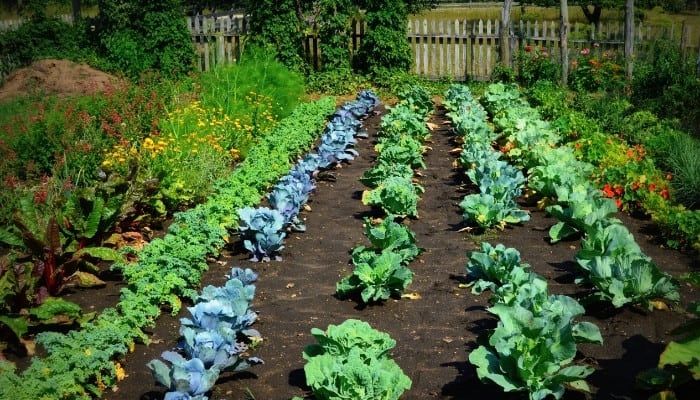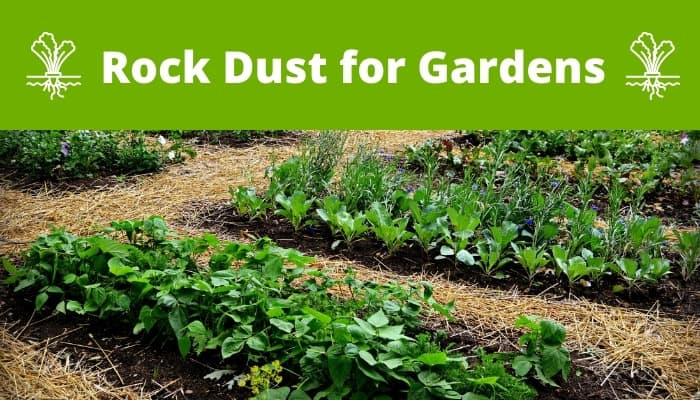It is a well-known fact that the greater the number of plants grown in a garden, the lower the amount of nutrients present in the soil.
Sooner or later, you’ll notice that the veggies and flowers you grow are either stunted or suffer from diseases. Even with regular fertilizers, your soil remains impoverished.
You need to replenish the missing nutrients and put back in the soil the minerals that those plants have absorbed.
What is rock dust? Rock dust is the pulverized rock that occurs naturally near ancient volcanoes and glaciers. It can also be a byproduct in stone and granite mining. Common types of rock dust include limestone, granite dust, and basalt dust. The powder is rich in minerals that many plants need to grow successfully.
Rock dust is a sustainable source of micronutrients. To use it to amend the soil in your garden, it has to be in fine-powder form so that it will break down quickly.
Read more to find out all you need to know about rock dust and how to use it to replenish the minerals in the soil.
What Is Rock Dust Used For?
Before it was used as a rich source of minerals to replenish and improve the soil, rock dust had been used in mines. It acts as a heat sink that prevents coal powder from catching fire in the mine.
Coal dust is an inflammable and very hazardous material with negative health impacts on the miners.
With rock dust, the levels of coal dust are kept manageable inside of the mine to protect the miners against black lung disease.
Recently, gardeners started adding rock dust to the garden to pump a dose of minerals into the soil.
Since it’s affordable and readily available, rock dust is a great addition to organic gardens. It enriches the soil at a fraction of the cost of many commercial food supplements on the market.
Does Rock Dust Really Work?
Although some gardeners would disagree, rock dust actually works in improving the soil.
The effects of adding rock dust to the garden can be seen in the next plants you grow after amending the soil.
Provided that the soil is rich in microorganisms and that you have allowed them enough time to break down the minerals, the new plants will have improved cell structures and high resistance to diseases and infections.
If you’re growing veggies or fruits, the crop will have better flavor and a bigger yield. Flower plants tend to have an abundance of blooms with richer colors thanks to the mineral-rich soil.
What Does Rock Dust Add to Soil?
Far from being an alternative to fertilizers, rock dust should be treated as a plant food supplement.
It lacks any of the three basic components of balanced fertilizers since it doesn’t have any nitrogen, phosphorus, or potassium.
However, rock dust contains a high concentration of minerals and micronutrients that many plants need in trace amounts.
Rock dust also feeds the microorganisms in the soil, which increases their activity to break down the organic matter.
Additionally, it improves the binding and exchange capacity of the soil particles with minerals and other micronutrients.
Rock Dust Minerals
The mineral content you can find in rock dust varies depending on the type and origins of the rock itself. In some estimates, rock dust has about 70 types of minerals.
However, many rock dust types will contain silicon, aluminum, and iron in high concentrations.
You might also find trace amounts of zinc, manganese, calcium, copper, sulfur, magnesium, and potassium.
Types of Rock Dust
Rock dust comes in different types. Where the rock is mined will impact the minerals and micronutrients it contains and in what amounts.
If your soil lacks a certain micronutrient, such as iron, then you should get the rock dust type that has a high concentration of that mineral.
Glacial Rock Dust
Glacial rock dust is the product of the natural movement of the glaciers. When the glacier expands or contracts, it grinds rocks in the process rendering them into powder.
This dust is rich in micronutrients including potassium, calcium, iron, and magnesium in addition to trace amounts of other minerals. It improves soil texture, bacteria activity, and water retention.
Basalt Rock Dust
Basalt rock dust is one of the richest rock powders that develop near volcanoes. When lava and magma that the volcano spits out cools off, it turns into rocks.
These rocks are collected and pulverized to create basalt rock dust. It contains all the minerals that came out from the bottom of the earth including silica, calcium oxide, and iron oxide.
Adding basalt rock dust to the soil improves the plants’ tolerance for harsh weather conditions, drought, and diseases.
Volcanic Rock Dust
Similar to basalt rock dust, volcanic rock dust is the product of igneous rocks being thrown out of active volcanoes.
They are easy to break down in the soil by the roots of the plants and microorganisms. That makes the silica, iron, and calcium more accessible to the roots as soon as they get mixed into the soil.
Silica is an essential ingredient in building the cells of the plants for an improved plant structure.
Granite Rock Dust
Another powder that is the byproduct of the mining industry, granite rock dust results from breaking large slabs of granite. The small granite pebbles and shards are collected and pulverized.
It has a high content of potassium, which is one of the three macronutrients that most plants need. It also contains trace amounts of calcium and magnesium-rich carbonates.
Is Azomite the Same as Rock Dust?
Azomite is compacted volcanic ash. Whereas rock dust is the product of rocks being pulverized either naturally or intentionally, Azomite occurs naturally as ash that got moist and then dried up and turned into rocks.
Moreover, Azomite contains higher concentrations of more minerals than can be found in rock dust. Commercial Azomite is sourced from a single mine in Utah.
Is Diatomaceous Earth the Same as Rock Dust?
Although both diatomaceous earth and rock dust are used to amend the soil, rock dust is by far the richer of the two in terms of mineral content.
For the most part, diatomaceous earth is about 85% silica with little or zero amounts of any other micronutrients.
If you want to enrich the soil and replenish its mineral content, then you should use rock dust.
Is Rock Phosphate the Same as Rock Dust?
Rock phosphate has high concentrations of phosphorus. Clay deposits are gathered and processed to create rock phosphate, which is used as a fertilizer.
Rock dust, on the other hand, doesn’t contain macronutrients and is rich in micronutrients.
What Plants Benefit From Rock Dust?
Almost all plants that flower and fruit would benefit from rock dust. The micronutrients in the dust give the plants a boost in growth, improve root development, and lead to bigger and more flowers.
Your veggies and fruits will taste better after adding rock dust to the garden. Flowering and ornamental plants will tend to have more lush foliage and brighter blooms.

Is Rock Dust Good for Tomatoes?
Studies show that rock dust can increase the yield of tomatoes considerably. Additionally, the minerals and micronutrients in rock dust improved the tomato plants’ growth and disease resistance.
Choose rock dust products with high concentrations of calcium carbonate and calcium oxide for best results in disease control in your tomato plants.
How To Use Rock Dust
You should add rock dust to the soil in small amounts since the minerals take time to break down and become available for the roots of the plants.
In general, you should amend the soil with 1 tablespoon of rock dust for every gallon of soil. Mix it into the top 4 inches of the soil once a month for the best results.
When Should I Apply Azomite to My Garden?
Azomite is rich in minerals, and it is said to contain all the minerals that plants need to grow. You should apply Azomite once every 3 months during the growing season.
You can also mix it with the irrigation water in small doses and add it to the soil on a weekly basis.
Can You Use Too Much Rock Dust?
Since rock dust contains natural minerals and micronutrients in small amounts, adding too much rock dust to the soil will not harm the plants or the microorganisms that live in the soil.
Unlike commercial fertilizers, rock dust doesn’t burn the roots nor trigger a sudden growth spurt that stresses the plants.
Final Thoughts
Rock dust is a great addition to organic gardening. The affordable material is rich in micronutrients that your veggies, fruits, and flowers need.
Besides improving the soil structure, rock dust also feeds the microorganisms that break down the organic materials in the soil.
Before adding rock dust, get an analysis of the soil to decide on the best rock dust type that contains the minerals your soil lacks.

